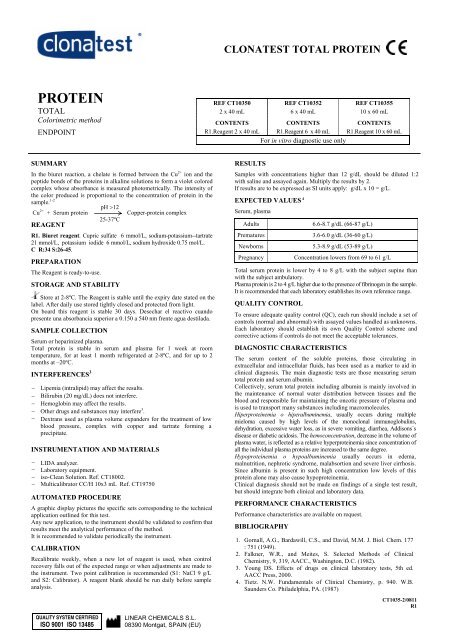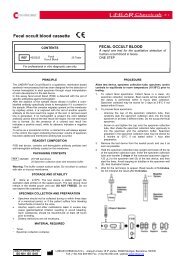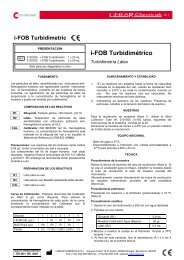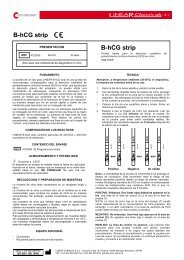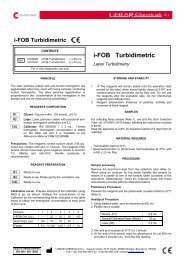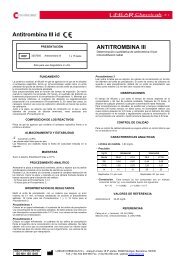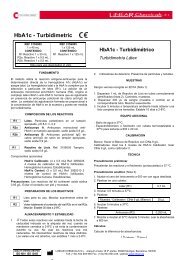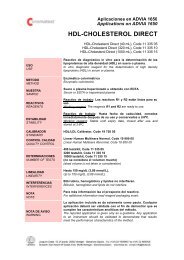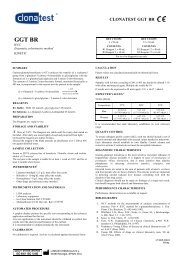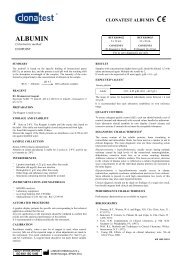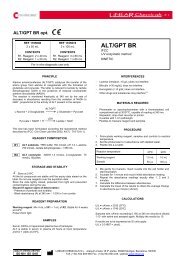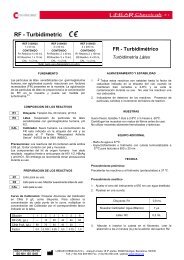PROTEIN - Linear
PROTEIN - Linear
PROTEIN - Linear
Create successful ePaper yourself
Turn your PDF publications into a flip-book with our unique Google optimized e-Paper software.
CLONATEST TOTAL <strong>PROTEIN</strong><br />
<strong>PROTEIN</strong><br />
TOTAL<br />
Colorimetric method<br />
ENDPOINT<br />
REF CT10350 REF CT10352 REF CT10355<br />
2 x 40 mL 6 x 40 mL 10 x 60 mL<br />
CONTENTS CONTENTS CONTENTS<br />
R1.Reagent 2 x 40 mL R1.Reagent 6 x 40 mL R1.Reagent 10 x 60 mL<br />
For in vitro diagnostic use only<br />
SUMMARY<br />
In the biuret reaction, a chelate is formed between the Cu 2+ ion and the<br />
peptide bonds of the proteins in alkaline solutions to form a violet colored<br />
complex whose absorbance is measured photometrically. The intensity of<br />
the color produced is proportional to the concentration of protein in the<br />
sample. 1-2<br />
pH >12<br />
Cu 2+ + Serum protein Copper-protein complex<br />
25-37ºC<br />
REAGENT<br />
R1. Biuret reagent. Cupric sulfate 6 mmol/L, sodium-potassium--tartrate<br />
21 mmol/L, potassium iodide 6 mmol/L, sodium hydroxide 0.75 mol/L.<br />
C R:34 S:26-45.<br />
PREPARATION<br />
The Reagent is ready-to-use.<br />
STORAGE AND STABILITY<br />
Store at 2-8ºC. The Reagent is stable until the expiry date stated on the<br />
label. After daily use stored tightly closed and protected from light.<br />
On board this reagent is stable 30 days. Desechar el reactivo cuando<br />
presente una absorbancia superior a 0.150 a 540 nm frente agua destilada.<br />
SAMPLE COLLECTION<br />
Serum or heparinized plasma.<br />
Total protein is stable in serum and plasma for 1 week at room<br />
temperature, for at least 1 month refrigerated at 2-8ºC, and for up to 2<br />
months at –20ºC.<br />
INTERFERENCES 3<br />
−<br />
−<br />
−<br />
−<br />
−<br />
Lipemia (intralipid) may affect the results.<br />
Bilirubin (20 mg/dL) does not interfere.<br />
Hemoglobin may affect the results.<br />
Other drugs and substances may interfere 3 .<br />
Dextrans used as plasma volume expanders for the treatment of low<br />
blood pressure, complex with copper and tartrate forming a<br />
precipitate.<br />
INSTRUMENTATION AND MATERIALS<br />
−<br />
−<br />
−<br />
−<br />
LIDA analyzer.<br />
Laboratory equipment.<br />
iso-Clean Solution. Ref. CT18002.<br />
Multicalibrator CC/H 10x3 mL Ref. CT19750<br />
AUTOMATED PROCEDURE<br />
A graphic display pictures the specific sets corresponding to the technical<br />
application outlined for this test.<br />
Any new application, to the instrument should be validated to confirm that<br />
results meet the analytical performance of the method.<br />
It is recommended to validate periodically the instrument.<br />
CALIBRATION<br />
Recalibrate weekly, when a new lot of reagent is used, when control<br />
recovery falls out of the expected range or when adjustments are made to<br />
the instrument. Two point calibration is recommended (S1: NaCl 9 g/L<br />
and S2: Calibrator). A reagent blank should be run daily before sample<br />
analysis.<br />
RESULTS<br />
Samples with concentrations higher than 12 g/dL should be diluted 1:2<br />
with saline and assayed again. Multiply the results by 2.<br />
If results are to be expressed as SI units apply: g/dL x 10 = g/L.<br />
EXPECTED VALUES 4<br />
Serum, plasma<br />
Adults<br />
Prematures<br />
Newborns<br />
Pregnancy<br />
6.6-8.7 g/dL (66-87 g/L)<br />
3.6-6.0 g/dL (36-60 g/L)<br />
5.3-8.9 g/dL (53-89 g/L)<br />
Concentration lowers from 69 to 61 g/L<br />
Total serum protein is lower by 4 to 8 g/L with the subject supine than<br />
with the subject ambulatory.<br />
Plasma protein is 2 to 4 g/L higher due to the presence of fibrinogen in the sample.<br />
It is recommended that each laboratory establishes its own reference range.<br />
QUALITY CONTROL<br />
To ensure adequate quality control (QC), each run should include a set of<br />
controls (normal and abnormal) with assayed values handled as unknowns.<br />
Each laboratory should establish its own Quality Control scheme and<br />
corrective actions if controls do not meet the acceptable tolerances.<br />
DIAGNOSTIC CHARACTERISTICS<br />
The serum content of the soluble proteins, those circulating in<br />
extracellular and intracellular fluids, has been used as a marker to aid in<br />
clinical diagnosis. The main diagnostic tests are those measuring serum<br />
total protein and serum albumin.<br />
Collectively, serum total protein including albumin is mainly involved in<br />
the maintenance of normal water distribution between tissues and the<br />
blood and responsible for maintaining the oncotic pressure of plasma and<br />
is used to transport many substances including macromolecules.<br />
Hiperproteinemia o hiperalbuminemia, usually occurs during multiple<br />
mieloma caused by high levels of the monoclonal immunoglobulins,<br />
dehydration, excessive water loss, as in severe vomiting, diarrhea, Addisons´s<br />
disease or diabetic acidosis. The hemoconcentration, decrease in the volume of<br />
plasma water, is reflected as a relative hyperproteinemia since concentration of<br />
all the individual plasma proteins are increased to the same degree.<br />
Hypoproteinemia o hypoalbuminemia usually occurs in edema,<br />
malnutrition, nephrotic syndrome, malabsortion and severe liver cirrhosis.<br />
Since albumin is present in such high concentration low levels of this<br />
protein alone may also cause hypoproteinemia.<br />
Clinical diagnosis should not be made on findings of a single test result,<br />
but should integrate both clinical and laboratory data.<br />
PERFORMANCE CHARACTERISTICS<br />
Performance characteristics are available on request.<br />
BIBLIOGRAPHY<br />
1.<br />
2.<br />
3.<br />
4.<br />
Gornall, A.G., Bardawill, C.S., and David, M.M. J. Biol. Chem. 177<br />
: 751 (1949).<br />
Falkner, W.R., and Meites, S. Selected Methods of Clinical<br />
Chemistry, 9, 319, AACC., Washington, D.C. (1982).<br />
Young DS. Effects of drugs on clinical laboratory tests, 5th ed.<br />
AACC Press, 2000.<br />
Tietz. N.W. Fundamentals of Clinical Chemistry, p. 940. W.B.<br />
Saunders Co. Philadelphia, PA. (1987)<br />
CT1035-2/0811<br />
R1<br />
QUALITY SYSTEM CERTIFIED<br />
ISO 9001 ISO 13485<br />
LINEAR CHEMICALS S.L.<br />
08390 Montgat, SPAIN (EU)
CLONATEST TOTAL <strong>PROTEIN</strong><br />
<strong>PROTEIN</strong>AS<br />
TOTALES<br />
Método colorimétrico<br />
PUNTO FINAL<br />
REF CT10350 REF CT10352 REF CT10355<br />
2 x 40 mL 6 x 40 mL 10 x 60 mL<br />
CONTENIDO CONTENIDO CONTENIDO<br />
R1.Reactivo 2 x 40 mL R1.Reactivo 6 x 40 mL R1.Reactivo 10 x 60 mL<br />
Sólo para uso diagnóstico in vitro<br />
FUNDAMENTO<br />
En la reacción del biuret se forma un quelato entre el ión Cu 2+ y los<br />
enlaces peptídicos de las proteínas en medio alcalino con la formación de<br />
un complejo coloreado violeta cuya absorbancia se mide<br />
fotométricamente. La intensidad del color producido es proporcional a la<br />
concentración de proteínas en la muestra. 1-2<br />
pH >12<br />
Cu 2+ + Proteína sérica Complejo cobre-proteína<br />
25-37ºC<br />
REACTIVO<br />
R1. Reactivo biuret. Sulfato cúprico 6 mmol/L, tartrato-sódico-potásico<br />
21 mmol/L, ioduro potásico 6 mmol/L, hidróxido sódico 0,75 mol/L.<br />
C R:34 S: 26-45<br />
PREPARACION<br />
El Reactivo está listo para su uso.<br />
ALMACENAMIENTO Y ESTABILIDAD<br />
Conservar a 2-8ºC. El Reactivo es estable hasta la fecha de caducidad<br />
indicada en la etiqueta. Después de su uso diario, mantener bien cerrado y<br />
protegido de la luz. En el analizador es estable 30 días. Discard the reagent if<br />
presents an absorbance over 0,150 at 540 nm against distilled water.<br />
MUESTRAS<br />
Suero o plasma heparinizado.<br />
Las proteínas totales son estables en suero y plasma 1 semana a temperatura<br />
ambiente, como mínimo 1 mes a 2-8ºC y hasta 2 meses a –20ºC.<br />
INTERFERENCIAS 3<br />
−<br />
−<br />
−<br />
−<br />
−<br />
Lipemia (intralipid) puede afectar los resultados.<br />
Bilirrubina (20 mg/dL) no interfiere.<br />
Hemoglobina puede afectar los resultados.<br />
Otros medicamentos y sustancias pueden interferir 3 .<br />
Los dextranos, empleados como expansores plasmáticos en el tratamiento<br />
de la presión sanguínea baja, forman un complejo que precipita al<br />
interaccionar con el cobre y el tartrato del reactivo.<br />
EQUIPO ADICIONAL<br />
−<br />
−<br />
−<br />
−<br />
Analizador LIDA.<br />
Material de laboratorio.<br />
iso-Clean Solution. Ref. CT18002.<br />
Multicalibrator CC/H 10x3 mL Ref. CT19750<br />
TECNICA AUTOMATICA<br />
Una representación grafica visualiza los ajustes específicos<br />
correspondientes a la aplicación técnica diseñada para este ensayo.<br />
Cualquier aplicación nueva al instrumento deberá validarse para<br />
confirmar que los resultados cumplen las características del método.<br />
Se recomienda validar periódicamente el instrumento.<br />
CALIBRACION<br />
Recalibrar semanalmente, al cambiar el lote de reactivos, cuando los<br />
valores del control estén fuera del rango de aceptación o cuando se<br />
realicen ajustes en el instrumento. Se recomienda la Calibración de dos<br />
puntos (M1: ClNa 9 g/L y M2: Calibrador). Realizar un blanco del<br />
reactivo cada día de trabajo antes de analizar las muestras.<br />
QUALITY SYSTEM CERTIFIED<br />
ISO 9001 ISO 13485<br />
LINEAR CHEMICALS S.L.<br />
08390 Montgat, SPAIN (EU)<br />
CALCULOS<br />
Muestras con concentraciones de proteinas totales superiores a 12 g/dL<br />
deben diluirse 1:2 con solución salina y repetir el ensayo. Multiplicar los<br />
resultados por 2.<br />
Para expresar los resultados en unidades SI aplicar: g/dL x 10 = g/L.<br />
VALORES DE REFERENCIA 4<br />
Suero, plasma<br />
Adultos<br />
Prematuros<br />
Recien nacidos<br />
Gestantes<br />
6,6-8,7 g/dL (66-87 g/L)<br />
3,6-6,0 g/dL (36-60 g/L)<br />
5,3-8,9 g/dL (53-89 g/L)<br />
Concentración baja de 69 a 61 g/L<br />
Las proteínas totales séricas se hallan disminuídas de 4 a 8 g/L en<br />
pacientes recostados en relación a la tasa de sujetos no encamados.<br />
Plasma, las proteínas plasmáticas se hallan aumentadas de 2 a 4 g/L<br />
debido a la presencia de fibrinógeno en la muestra.<br />
Se recomienda que cada laboratorio establezca su propio rango de referencia.<br />
CONTROL DE CALIDAD<br />
Para un control de calidad (CC) adecuado, se incluirán en cada serie controles<br />
valorados (normal y abnormal) que se tratarán como muestras problema.<br />
Cada laboratorio debe establecer su propio Control de Calidad y sus medidas<br />
correctoras cuando los controles no cumplan con las tolerancias exigidas.<br />
SIGNIFICADO CLINICO<br />
Las proteínas del suero y de la albúmina se hallan mayoritariamente y en<br />
forma conjunta, implicadas en el mantenimiento de la normal distribución<br />
del agua entre los tejidos y la sangre siendo responsables de la<br />
regularización de la presión oncóntica del plasma además del transporte de<br />
muchas sustancias, incluyendo macromoléculas.<br />
La hiperproteinemia o hiperalbuminemia por lo general ocurre en el<br />
mieloma múltiple, causado por altos niveles de inmunoglobulinas<br />
monoclonales, deshidratación, excesiva pérdida de agua, como en vómitos<br />
severos, diarrea, enfermedad de Addison y diabetes acidósica. La<br />
hemoconcentración, descenso en el volumen de agua plasmática, se refleja<br />
como una hiperproteinemia relativa, al verse aumentadas en el mismo<br />
grado las concentraciones de todas las proteínas plasmáticas individuales.<br />
La hipoproteinemia o hipoalbuminemia se presenta en casos de<br />
malnutrición, edema, síndrome nefrótico, malaabsorción y cirrosis<br />
hepática severa. Al estar la albúmina presente a tan alta concentración el<br />
simple descenso de esta proteína puede ser causa de hipoproteinemia.<br />
El diagnóstico clínico no debe realizarse únicamente con los resultados de<br />
un único ensayo, sino que debe considerarse al mismo tiempo los datos<br />
clínicos del paciente.<br />
CARACTERISTICAS ANALITICAS<br />
Las características analíticas están disponibles bajo solicitud.<br />
REFERENCIAS<br />
1.<br />
2.<br />
3.<br />
4.<br />
Gornall, A.G., Bardawill, C.S., y David, M.M. J. Biol. Chem. 177 :<br />
751 (1949).<br />
Falkner, W.R., and Meites, S. Selected Methods of Clinical<br />
Chemistry, 9, 319, AACC., Washington, D.C. (1982).<br />
Young DS. Effects of drugs on clinical laboratory tests, 5th ed.<br />
AACC Press, 2000.<br />
Tietz. N.W. Fundamentals of Clinical Chemistry, p. 940. W.B.<br />
Saunders Co. Philadelphia, PA. (1987).


